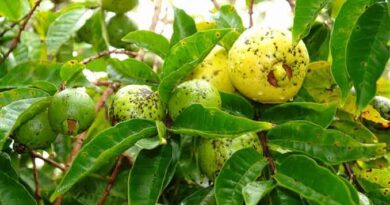Juvenility, Maturity and Senescence of Plants
During the life cycle of plants, they undergo some noticeable morphological changes from the embryonic phase to juvenile and maturity. These are phases of growth and development which is eventually followed by senescence and death.
After death the plant is said to have completed its life cycle. The juvenile phase in some species has a distinctive morphology of leaves, stems, and other structures which are no longer present when the plant becomes mature.
Once the plant reaches maturity, flowering can be induced by appropriate external signs. The change from mature to senescent conditions typically involves the deterioration of many synthetic reactions leading to the death of the plant, thereby completing the cycle.
Most plant start development from seed germination through the various growth stages to maturity.
Most characteristics change gradually during the period preceding the mature phase, and usually no distinct concurrent change in any one characteristic is apparent at the time the ability to flower is attained.
Phase change is of considerable theoretical importance relative to morphogenetic control and differentiation.
Physiological characteristics such as seasonal leaf retention and stem pigmentation, ability to form adventitious roots and buds, partitioning of photosynthates into main stem or branches, disease resistance and unfavourable weather resistance changes are characteristics that occur during development in plants and these vary from species to species.
Juvenility Phase of Plant

In the development of all woody plants from seed, there is a so-called juvenile phase lasting up to 30 – 40 years in certain forest trees, during which flowering does not occur and cannot be induced by the normal flower-initiating treatments or conditions.
In time, however, the ability to flower is achieved and maintained under natural conditions; at this stage, the tree is considered to have attained the adult or sexually mature condition.
The juvenile phase of plant development can be defined as an initial period of growth when apical meristems will not typically respond to internal or external conditions to initiate flowers.
The length of the juvenile period can be influenced by environmental as well as genetic factors.
This phase is characterized by exponential increases in size; absence of the ability to shift from vegetative growth to reproductive maturity leading to the formation of flowers once the plant reaches maturity, flowering can be induced by appropriate external signs.
The change from mature to senescent conditions typically involves the deterioration of many synthetic reactions leading to the death of the plant, thereby completing the cycle.
This transition from the juvenile to the mature phase could also be referred to as ontogenetic aging or meristem aging.
Morphological Characters of Juvenility
As the plant grows steadily through the years to maturity, you are likely going to see morphological changes in the plants external features like the shapes of the leaves and the length of the branches and other signs indicating maturity and flowering.
Associated with this transition are progressive changes in morphological and developmental attributes including leaf cuticular characteristics, bark characteristics, leaf shape and thickness, phyllotaxis, plastochron, thorniness, and shoot orientation, branch number and branching pattern, tracheid width and length, shoot growth vigor and other physiological characteristics such as seasonal leaf retention and stem pigmentation, ability to form adventitious roots and buds, partitioning of photosynthates into main stem or branches, disease resistance and unfavourable weather resistance.
Changes in such characteristics during development vary from species to species. Most characteristics change gradually during the period preceding the mature phase, and usually no distinct concurrent change in any one characteristic is apparent at the time the ability to flower is attained.
Read Also : Seed Germination and Dormancy to Plant Growth and Development
Maturity and Senescence
Attainment and maintenance of the ability or potential to flower is the only consistent criterion available to assess the termination of the juvenile period.
Once the plant attains this ability to flower, flowering will continue to occur so long as all other requisite environmental conditions are met.
If they are not, flowering will be delayed even though the plant is now capable of flowering. Thus, flowering can indicate that the plant has reached the phase of sexual maturity, but may not indicate when the transition occurred.
Conversely, lack of flowering may not mean that the plant is still in the sexually immature, juvenile phase.
However, for individual species, a specific character such as thorniness or anthocyanin formation may be correlated with ability to flower and thus be useful as an indicator of the termination of the juvenile period.
Once the sexually mature phase is attained, it is relatively stable. Reversion to the juvenile condition does not generally occur as a result of asexual propagation such as cuttage or graftage involving a single bud and a small piece of stem.
In summary, juvenility is part of the ageing process in woody plants. Commencement of flowering can indicate that the plant has reached the phase of sexual maturity though lack of flowering may not necessarily mean that the plant is still in the sexually immature, juvenile phase.
During the life cycle of a plant, it undergoes some noticeable morphological changes from the embryonic phase to juvenile and maturity. These are phases of growth and development which is eventually followed by senescence and death. After death the plant is said to have completed its life cycle.
The juvenile phase of plant development is the initial period of growth when apical meristems will not typically respond to internal or external conditions to initiate flowers.
As the plant grows steadily through the years to maturity, you are likely going to see morphological changes in the plants external features like the shapes of the leaves and the length of the branches and other signs indicating maturity and flowering.
Attainment and maintenance of the ability or potential to flower is the only consistent criterion available to assess the termination of the juvenile period.
Read Also : Food Poisoning: Types, Symptoms, & Treatment
Do you have any question, suggestion or other contributions? kindly use the comment box provided below for all your contributions. You are also encouraged to please kindly share this article with others you feel can benefit from this information if found useful enough as we may not be able to reach everyone at the same time. Thank you so much for sharing!









